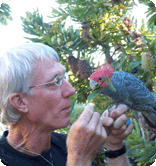How should I care for my aging Amazon parrots?

Dear EB,
I have 2 rehomed parrots since June 08 a bonded pair of Orange-winged Amazons around six years old. They are living in a large aviary 140 foot with 18 other mixed species. I have provided them with their own flight and 2 sheltered spots. It is now late October they are perching out in the driving rain. The hen has partially recovered form liver disease. (I treated her with antibiotic and hand fed her for 2 months) She is now thin. MY vet says not to hand feed her any longer. Can they survive the cold? Why do they not seek shelter? Their behavior puzzles me. They are not hand tame so I cannot pick them up and put them in the shelter. I have another pair of very old Orange-winged Amazons who behave a little similar fashion. They roost outside although a warm she is provided.
With thanks,
Dot

Dear Dot,
It is not at all unusual for amazon parrots, especially if they are former wild-trapped ones, to prefer perching outside rather than being under shelter. Sheltered roofs can be a perceived “trap” for many psittacine species.
If you catch the two or four elderly ones and place them inside for the winter, they will most likely live longer. You also could give them a late afternoon seed or nut feeding inside and coax them to come in before sunset, then lock them in. If your indoor arrangement does not provide a lock, then it is time to put one on. Parrots even on the verge of dying will retain
their sleeping habits to the detriment of their well being.
I do not know why your vet has said to stop hand-feeding one bird who is getting thin, but perhaps he does not want to stress it more—-sometimes it is not necessary to use a syringe and hold the bird, but instead one can just provide soaked warm sprouted wheat bread and extruded adult pellets and tofu and the like in a small cup, which the bird will then gulp like a baby would. Often a bird with a weak liver will lose weight because it is having real difficulty digesting the foods being offered. Easily digestible foods will be accepted more readily, certainly those that do not require crunching and are already in wet, warm form—a low, low fat diet is best .
I would be feeding this bird and keeping it and its mate in my house on a heating pad so that it would either recover slowly or would pass away in the most comfortable, gentle way possible. If you do hand feed it, do not use commercial baby formula as most of those are for growing birds and have far too much fat in them for a bird with liver disease. Also I would be giving that bird milk thistle extract in its water and on its wet food at least three times a week for liver health.
Good luck and my prayers are with these four old amazons. They have suffered a lot due to humans and deserve to be as comfortable as possible now.
Thank you for rescuing them.
With aloha, EB

































